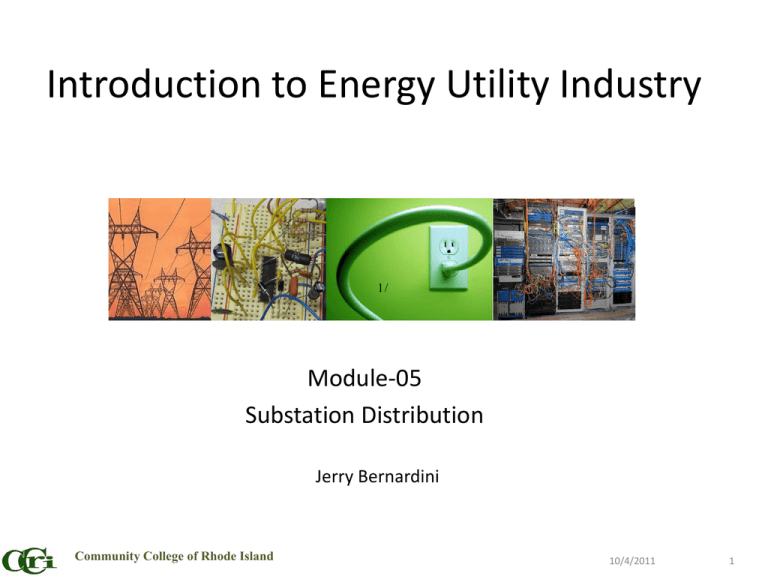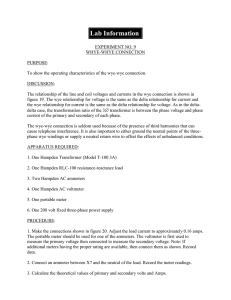Introduction to Energy Utility Industry
advertisement

Introduction to Energy Utility Industry 1/ Module-05 Substation Distribution Jerry Bernardini Community College of Rhode Island 10/4/2011 1 Substation Distribution References • “Electric Power Basics For the Nonelectrical Professional”, Steven W. Blume, IEEE Press, pp. 101-132 http://4294956165701126135-a-1802744773732722657-s-sites.googlegroups.com/site • • • • “An Introduction to Electric Power Distribution”, second edition, Wayne Beaty; pp. 33-66 “Basic Electric Power Distribution”, third edition, Anthony J. Pansini; pp. 165-182 "Three Phase Transformer Info”, http://www.electoolbox.com/usefulinfo/xfmr-3ph.htm Electrical engineering Tutorials, Electric Power Systems http://powerelectrical.blogspot.com/2007/03/electric-power-systems-and-its.html Community College of Rhode Island 10/4/2011 2 Simplified Electric Power System Community College of Rhode Island 10/4/2011 3 Substation to Consumer Distribution Systems • • • • • • • Systems are responsible for delivering electrical energy from the distribution substation to the service-entrance of customer/consumer Primaries lines are the high voltage side of the distribution transformer Secondary lines are the low-voltage side of the distribution transformer Secondary lines tie to the transformer and run from pole to pole. The consumer's service drop runs from the secondary line or transformer to our consumer's meter. Most distribution systems in the U.S. operate at primary voltages between 12.5 kV and 24.9 kV. Some operate at 34.5 kV and some operate at low-voltage distribution such as 4 kV. These low voltage distribution systems are being phased out. Community College of Rhode Island 10/4/2011 4 Distribution Components • At key locations along the distribution system, voltage is lowered by distribution transformers to the level needed by consumers • Reclosers are located throughout the distribution system to prevent a permanent outage due to a temporary fault – – will automatically restore the circuit when power is lost due to a temporary fault. If an outage occurs, reclosers will localize the fault in order to minimize the number of consumers affected. • Regulators maintain the voltage depending on consumer demand for electricity • Capacitors, which are found in substations and on poles, momentarily store electricity to help control and improve voltage regulation Community College of Rhode Island 10/4/2011 5 Substation Electrical Power Flow Community College of Rhode Island 10/4/2011 6 Step-up Transmission Substation • • • • Substations receives electric power from a nearby generating facility and uses a large power transformer to increase the voltage for transmission to distant locations. A transmission bus is used to distribute electric power to one or more transmission lines. A substation can have circuit breakers that are used to switch generation and transmission circuits in and out of service as needed Typical voltages are: – – – – High voltage (HV) ac: 69 kV, 115 kV, 138 kV, 161 kV, 230 kV Extra-high voltage (EHV) ac: 345 kV, 500 kV, 765 kV Ultra-high voltage (UHV) ac: 1100 kV, 1500 kV Direct-current high voltage (dc HV): ±250 kV, ±400 kV, ±500 kV Community College of Rhode Island 10/4/2011 7 Distribution Substation • • • • Stations are located near to the end-users. Distribution substation transformers change the transmission or subtransmission voltage to lower levels for use by end-users. Typical distribution voltages vary from 34,500/19,920 volts to 4,160/2400 volts. 34,500/19,920 volts is interpreted as a three-phase circuit with a grounded neutral source. – • This would have three high-voltage conductors or wires and one grounded neutral conductor, a total of four wires. The voltage between the three phase conductors or wires would be 34,500 volts and the voltage between one phase conductor and the neutral ground would be 19,920 volts Community College of Rhode Island 10/4/2011 8 Underground Distribution Subststion • Are also located near to the end-users. • Distribution substation transformers change the subtransmission voltage to lower levels for use by end-users. • Typical distribution voltages vary from 34,500/19,920 volts to 4,160/2400 volts. • An underground system may consist of these parts: – Conduits - Duct Runs –Manholes - High-Voltage Underground Cables – Transformer Vault- Riser - Transformers Community College of Rhode Island 10/4/2011 9 System Voltages and Categories • System voltage is a term used to identify whether reference is being made to secondary or primary distribution systems. • Residential, commercial, and small industrial loads are normally served with voltages under 600 volts. • Manufacturers have standardized the provision of insulated wire to have a maximum 600 Vac rating for “secondary” services. • For example, household wire such as extension cords has a 600 Vac insulation rating. • Other than changing the plugs and sockets on either end, one could use this wire for higher voltages such as 240 Vac (679 Vpp). Common Distribution Voltages Community College of Rhode Island 10/4/2011 10 Distribution Feeders • • • Radial distribution feeders have only one end of the distribution powerline is connected to a source. If the source for a radial end becomes opened (i.e., deenergized) the entire feeder is deenergized and all the consumers connected to that feeder are out of service. Distribution feeders might have several disconnect switches located throughout the line. This allows for: – – – load transfer capability isolation of line sections for maintenance Visual openings for safety Community College of Rhode Island 10/4/2011 11 Single and Three Phase Electrical Power • • • • Most residential application use single phase power Most Industrial applications use three phase power Most power transmission is three phase ( excluding HVDC) The main benefit of three phase power it is typically 150% more efficient than singe phase in the same power range. • Conductors are 75% the size of a singe phase for same power • Three phase invented by Nikola Tesla Community College of Rhode Island 10/4/2011 12 Electrical Phasors • • • • • • Electrical signals can be represented by phasors This a very useful way of viewing electrical power at different phase angles By convention phasors rotate counter clockwise As the phasor rotates the amplitude varies as a sine of the angle Electrical power different phases means they started at different times Three phase power mean three power sources that are synch but started 1/3 of a 60 Hz cycle apart Phasor-2 Phasor-1 Phasor-3 Community College of Rhode Island 10/4/2011 13 Wye-Delta Connections • Delta system – is a good short-distance distribution system. It is used for neighborhood and small commercial loads close to the supplying substation. – Only one voltage is available between any two wires in a delta system. • Wye System – the voltage between any two wires will always give the same amount of voltage on a three phase system. – the voltage between any one of the phase conductors (X1, X2, X3) and the neutral (X0) will be less than the power conductors. – For example, if the voltage between the power conductors of any two phases of a three wire system is 208v, then the voltage from any phase conductor to ground will be 120v. – This is due to the square root of three phase power. In a wye system, the voltage between any two power conductors will always be 1.732 (which is the square root of 3) times the voltage between the neutral and any one of the power phase conductors. – The phase-to-ground voltage can be found by dividing the phase-to-phase voltage by 1.732 Community College of Rhode Island 10/4/2011 14 Wye and delta Feeders and connections • Most of the three-phase distribution feeders and transformer connections use the wye system alternative because it offers more advantages than disadvantages. • Although delta distribution systems do exist, much of the delta distribution has been converted to wye. • The wye connection has one wire from each coil connected together to form the neutral. Most of the time, this neutral is grounded. Grounding gives earth an electrical reference Grounded Community College of Rhode Island 10/4/2011 15 Earth Grounding • The earth surface is conductive most of the time. • Depending on the type of soil – (rich fertile soil vs. granite rock) – the condition of the soil (wet vs. dry) – earth can be a very good conductor or a very poor conductor (i.e., a very good insulator) or both, depending on the season. • A reliable earth connection provides – – – – neutral zero voltage reference improves such things as safety Improves voltage stability Improves protection system design. Community College of Rhode Island 10/4/2011 16 Delta-Wye Issues • Most are wye, indicating a four-wire power line having line to-line voltages and line-to-neutral voltages. • The common adopted standard is the wye–wye configuration distribution transformer bank. • The preferred method of connecting equipment is by four-wire wye connected to four-wire wye–wye distribution transformers on a four-wire wye primary. • Transmission and subtransmission lines are built as three-phase, three-wire lines. Neutral is not provided on transmission lines • The ends of the transmission lines are connected to either delta or source grounded wye transformer connections. • “Source-grounded wye” connection means that the transmission transformer in the substation is a four-wire wye transformer that has the three phases connected to the line conductors and the neutral connected to the substation ground grid. Community College of Rhode Island 10/4/2011 17 Delta-Wye Issues-2 • Most distribution systems use grounded-wye connections – Current is usually present in the neutral because the three phase currents are normally not balanced. • Three wire delta distribution lines exist, primarily in rural areas where a neutral is not present. – Those lines are more vulnerable to stray currents and voltages through the earth as the earth tries to balance the current flow. • The preferred standard for distribution is the grounded-wye configuration. Community College of Rhode Island 10/4/2011 18 Typical Single Transformer Configurations http://www.bmillere ngineering.com/elec sys.htm Community College of Rhode Island 10/4/2011 19 Typical ThreePhase Three-Wire Delta Configurations http://www.bmillere ngineering.com/elec sys.htm Community College of Rhode Island 10/4/2011 20 Typical ThreePhase Three-Wire Wye Configurations http://www.bmillere ngineering.com/elec sys.htm Community College of Rhode Island 10/4/2011 21 Typical ThreePhase Four-Wire Wye Configurations http://www.bmillere ngineering.com/elec sys.htm Community College of Rhode Island 10/4/2011 22 Mostly advantages of Grounded-Wye • • • • • Common ground reference. The common ground improves voltage stability Easier to detect line-to-ground faults. Better single-phase protection with fuses. Common practice on delta systems to replace all three fuses • Disadvantage-Requires four conductors. Delta systems require only three conductors for threephase power. Community College of Rhode Island 10/4/2011 23 Delta Advantages and Disadvantages • Advantages: – Delta systems require only three conductors for three-phase power. – Power quality enhancement and third-order harmonics are eliminated due to a natural cancellation. – Minimize the effect that lightning has on a system. • Disadvantages: – No ground reference. – Stray currents. Distribution transformers can cause stray currents to flow in the earth when their low-voltage secondary side is grounded. – Unbalanced currents. Three-phase transformer banks can regulate the primary voltage or try to equalize the primary voltage. • Comparing all the advantages and disadvantages, the multi-grounded neutral, four-wire wye-distribution feeder is the preferred method. Community College of Rhode Island 10/4/2011 24 Wye Primaries Overhead • Wye-connected primary distribution lines consist of three phases and a neutral • The neutral is grounded at every pole in most systems. • Some rural grounded-wye systems might follow grounding a minimum of five grounds per mile • a continually grounded neutral is referred to as a multigrounded neutral (MGN). Community College of Rhode Island 10/4/2011 25 Delta Primaries • • • • Delta primary distribution lines use three conductors (one for each phase) and no neutral. Single-phase transformers must have two high-voltage bushings and each bushing must connect directly to different phases. Delta primaries do not have primary neutrals, the transformer tank grounds and lightning arrester grounds must be connected to a ground rod at the base of the pole with a ground wire along the side of the pole. Delta primaries and fused laterals require single-phase transformers to be connected phase to phase. Community College of Rhode Island 10/4/2011 26 Residential Transformer Connections • Standard residential service voltage is 120/240 Vac, most distribution transformers have turns ratios that produce the 120/240 Vac on their secondary or lowvoltage side. • The residential distribution transformer has two secondary windings Community College of Rhode Island 10/4/2011 27 Transformer Connections • The most common transformer configurations: – phase to neutral (i.e., line to ground) for single-phase connections – wye–wye for three-phase transformer-bank connections. connection – The most common for a distribution transformer, single phase or three phase, is phase to ground (i.e., line to ground). Community College of Rhode Island 10/4/2011 28 Transformer Secondary Connections: Residential • • • • • In order to produce the two 120 Vac sources (to make up the 120 Vac and the 240 Vac service) for the residential consumer, the distribution transformer has two secondary windings. This is the most standard connection configuration for residential consumers. This single-phase transformer has the two 120 Vac low-side voltage terminals connected in series with a neutral connection in the middle. This transformer supplies 120/240 volts single phase service to residential customers. Note the two secondary windings in series. Example: 12.5 kV line-to-line, line-neutral 7.2 kV (12.5/1.73), turns ratio (N) =60:1; 240V = 7200V/60 Single-Phase OneBushing Transformer High-Voltage side (bushings) Community College of Rhode Island 10/4/2011 29 Three-Phase Distribution Transformers • Three single-phase transformers are used to produce three-phase service for commercial and industrial consumers. • Small commercial and industrial consumers are normally served with 208/120 Vac three-phase service. • Larger commercial and industrial consumers are normally served with 480/277 Vac three-phase service. (three transformer bank) Community College of Rhode Island 10/4/2011 30 Dry Pack Transformers • • • • • • Consumers that take service at 480/277 Vac usually require dry-pack transformers at their facility to provide 208/120 Vac service to power standard receptacles and other basic 120 Vac necessities. Dry pack implies no insulation oil is contained in the transformer. Dry pack transformers are often located in closets or small rooms with high-voltage warning signs posted on the door Most of the large motor loads (i.e., elevators) at these larger consumers operate at 480 Vac three-phase. The large arrays of lighting use 277 Vac line-to-ground single-phase power. Just the basic 120 V loads use the dry-pack transformers. Community College of Rhode Island 10/4/2011 31 Fuses and Cutouts • • • • The purposes of a fuse are to interrupt power flowing to equipment when excessive current occurs and to provide equipment damage protection due to short circuits and power faults. Fuse takes a very short period of time to melt open when the current rating is exceeded. The higher the excessive current, the faster the fuse melts. Fuse Cutouts are used to protect distribution transformers, underground feeds, capacitor banks, PTs, and other equipment. When blown, the fused cutout door falls open and provides a visible break in the circuit for line workers to see. Cutout door open Cutout door closed Community College of Rhode Island 10/4/2011 32 Under Ground Service • • • • • • • Underground construction is usually about three to five times more costly than overhead construction. Most people prefer underground construction as opposed to overhead. Underground systems are not exposed to birds, trees, wind, and lightning, and should be more reliable. However, underground systems fault due to cable, elbow, splice, dig-in, and connector failures. When underground systems fault, they usually cause significant damage (i.e., cable, elbow, or splice failure). Therefore, underground feeders are usually not automatically reclosed Community College of Rhode Island 10/4/2011 33 Primary Underground Cable • • • • • • • Primary underground cables are one of the most important parts of any underground system. If a fault occurs on an underground cable, the feeder or fused section of line is out of service until a crew can isolate the bad section of cable and perform necessary load-transfer switching to restore power. Most primary distribution of two conductors (main center conductor and concentric neutral conductor) with layers of insulation and semiconductive wraps. The main center conductor is composed of either copper or aluminum. The outer conductor is the concentric neutral and is usually copper. The outer cover jacket is made of polyethylene, polyvinyl chloride (PVC), or thermoplastic material. The concentric neutral helps trip a circuit breaker or fuse quickly if dug into by a backhoe or other equipment. Should a backhoe operator penetrate the cable, the blade is first grounded by the concentric neutral before striking the center conductor. This allows short-circuit current to flow and trip the breaker. helps trip a circuit breaker or fuse quickly if dug into Community College of Rhode Island 10/4/2011 34


